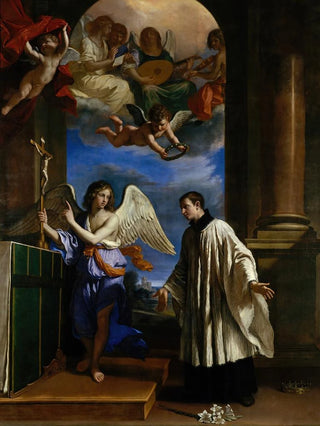Art print | The vocation of Saint Louis de Gonzague - Guercino


View from behind

Frame (optional)
In the vast panorama of art history, certain works stand out for their ability to transcend time and touch the human soul. "The Calling of Saint Louis de Gonzague" by Guercino is a perfect example. This painting, which depicts the decisive moment in a young man's quest for spirituality, invites deep reflection on vocation and devotion. Through this artwork, Guercino manages to capture the very essence of faith and determination, offering a window into the saint's soul and the values he embodies. The intensity of emotions and the depth of the gazes immerse the viewer in a universe where the sacred and the human meet.
Style and uniqueness of the work
Guercino's style is characterized by an exceptional mastery of light and shadow, a technique known as chiaroscuro. In "The Calling of Saint Louis de Gonzague," this technique is used with such virtuosity that the figures seem to detach from the background, creating an almost tangible atmosphere. The colors, both rich and nuanced, enhance the emotional impact of the scene. The expressions of the characters, especially that of Saint Louis, reveal a psychological depth that invites contemplation. Every detail, from the folds of the robe to the play of light on the face, demonstrates a concern for realism and a pursuit of beauty that are characteristic of Baroque art. Guercino succeeds in combining powerful storytelling with impeccable technical execution, making this work a true masterpiece.
The artist and his influence
Guercino, whose real name is Giovanni Francesco Barbieri, is one of the masters of Italian Baroque. Born in 1591 in Cento, he established himself as an essential artist of his time. His style, influenced by Caravaggio and the great masters of the Renaissance, marked a generation of artists and continues to inspire contemporary creators. "The Calling of Saint Louis de Gonzague," completed in 1625, perfectly illustrates Guercino's commitment to exploring religious themes with a human and accessible approach. Through his art, he manages to establish a

Matte finish

View from behind

Frame (optional)
In the vast panorama of art history, certain works stand out for their ability to transcend time and touch the human soul. "The Calling of Saint Louis de Gonzague" by Guercino is a perfect example. This painting, which depicts the decisive moment in a young man's quest for spirituality, invites deep reflection on vocation and devotion. Through this artwork, Guercino manages to capture the very essence of faith and determination, offering a window into the saint's soul and the values he embodies. The intensity of emotions and the depth of the gazes immerse the viewer in a universe where the sacred and the human meet.
Style and uniqueness of the work
Guercino's style is characterized by an exceptional mastery of light and shadow, a technique known as chiaroscuro. In "The Calling of Saint Louis de Gonzague," this technique is used with such virtuosity that the figures seem to detach from the background, creating an almost tangible atmosphere. The colors, both rich and nuanced, enhance the emotional impact of the scene. The expressions of the characters, especially that of Saint Louis, reveal a psychological depth that invites contemplation. Every detail, from the folds of the robe to the play of light on the face, demonstrates a concern for realism and a pursuit of beauty that are characteristic of Baroque art. Guercino succeeds in combining powerful storytelling with impeccable technical execution, making this work a true masterpiece.
The artist and his influence
Guercino, whose real name is Giovanni Francesco Barbieri, is one of the masters of Italian Baroque. Born in 1591 in Cento, he established himself as an essential artist of his time. His style, influenced by Caravaggio and the great masters of the Renaissance, marked a generation of artists and continues to inspire contemporary creators. "The Calling of Saint Louis de Gonzague," completed in 1625, perfectly illustrates Guercino's commitment to exploring religious themes with a human and accessible approach. Through his art, he manages to establish a






